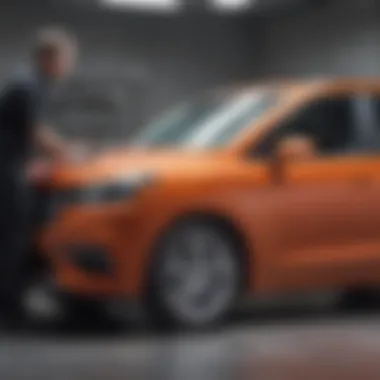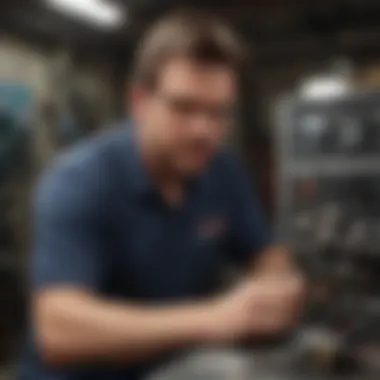Your Comprehensive Guide to Ding and Dent Repair


Intro
Ding and dent repair plays a crucial role in automotive care. Understanding it enhances service quality, saves time, and reduces costs. Vehicles gather minor damage over time, which can detract from their aesthetic appeal and resale value. Local repair services address these issues, but finding the right specialist can be daunting. This guide aims to elucidate various facets of ding and dent repair.
Understanding Ding and Dent Repairs
Dents and dings generally come from minor accidents or weather-related incidents. Learning about common repair methods helps in assessing suitable services. It is important to differentiate between small dents that may require straightforward techniques and larger or more complicated damage. Familiar tools and methods include paintless dent repair and traditional bodywork techniques. Checking for trained professionals in these methods can contribute to a better repair outcome.
For a comprehensive understanding of this topic, you may refer to sources such as Wikipedia for background knowledge or Britannica for detailed explanations.
Factors to Consider When Selecting Repair Services
When searching for ding and dent repair, it's crucial to keep certain criteria in mind:
- Expertise: Look for specialists who have considerable experience with minor auto body repairs.
- Reviews: Customer feedback is invaluable in determining service quality. Websites such as Reddit often have discussions regarding specific professionals or local shops.
- Price Estimates: Requesting quotes from multiple providers will help you gauge fair pricing.
By adhering to these practices, one can avoid common pitfalls and engage with reliable services.
Understanding Ding and Dent Repair
Ding and dent repair is a crucial aspect of automotive care, essential for maintaining the aesthetic and structural integrity of a vehicle. Understanding this topic can aid car owners in making informed decisions regarding damage repair, thus potentially saving time and money long-term.
Evaluating the condition of a car involves recognizing the kinds of minor damages that can accumulate over time. Even slight imperfections can lead to larger issues if left unattended. Therefore, having a grasp on what ding and dent repair entails opens pathways to proactive vehicle maintenance, subsequently influencing resale value.
Moreover, comprehending the repair options available equips drivers with the means to communicate effectively with service providers. Costs, repair timeframes, and procedural transparency become vital factors when choosing the right repair shop. With the transformative nature of these repairs, selecting competent professionals ultimately enhances a vehicle’s value and prolongs its lifespan.
Definition of Ding and Dent Repair
Ding and dent repair refere to methods utilized to correct minor damages to a vehicle’s surface. This can involve small impacts that cause little to moderate damage, primarily affecting the paint and body of the car. Typical examples include dings caused by car doors, hail, or shopping carts. These repairs help restore both appearance and functionality of the vehicle.
The methods involved may differ in complexity and approach, with some being relatively simple and cost-effective while others may run into higher expenses or longer wait times. Delivery of efficient repair solutions relies on correct identification of the damage type and extent.
Common Causes of Dings and Dents
Dings and dents arise from multiple sources. Frequently, they are the result of daily interactions in busy environments. Below are several common causes:
- Accidental Hits: This includes minor bumps or collisions, often in parking lots.
- Weather Inducement: Natural incidents like hail can leave significant marks, especially on the roof and hood of the vehicle.
- Mismanagement: Careless handling while others park, loading groceries, or children playing can also lead to small misfortunes in a vehicle’s exterior.
Recognizing these causes empowers car owners to take proactive measures to prevent future issues. Understanding potential damages can also lead to better defensive driving habits and parking choices, which might ultimately protect a vehicle’s finish.
Types of Repairs
Understanding the different types of repairs available for dings and dents is crucial for consumers looking to maintain their vehicles. Vehicles experience minor damage frequently, and how these issues are remedied can significantly impact both the vehicle's aesthetic appearance and its resale value. This section will delve into the two primary methodologies used in ding and dent repair, offering insights into the processes involved and helping readers make informed choices based on their specific situations.
Paintless Dent Repair
Technique Overview
Paintless Dent Repair (PDR) is a revolutionary method utilized for the repair of dings and dents without the need for repainting. The process involves access to the damaged area of the vehicle from behind the dent, where specialized tools gently manipulate the metal back to its original shape.
One key characteristic of this technique is that it preserves the vehicle's original paint. This is important, as the majority of car owners prefer original factory paint. The primary contribution of PDR to the overall context of ding and dent repair is its ability to repair minor damage quickly and cost-effectively.
A significant feature is its minimal effect on the surrounding area, ensuring that all repairs are confined to the damaged area without any risk of paint hyperpigmentation or mismatching that often arises from traditional work.
Advantages and Limitations
While Paintless Dent Repair presents numerous advantages, it does come with some limitations as well. On the advantage side, PDR is generally faster than traditional methods, often taking mere hours rather than days. It is also less costly due to the absence of materials needed for filler and paint.


An important limitation to consider is that PDR is effective only on specific types of damage. Deep dents or those on complex curves may not be fixable using this technique. Understanding when to apply this method is key in making the right decision for vehicle repair needs.
Traditional Repair Methods
Filler Use
Traditional repair methods typically involve the application of body filler, a necessary step once the damaged area has been assessed. Body filler is a malleable compound applied to surface imperfections and is used to restore the vehicle to a seamless finish.
A defining characteristic of filler use is its capability to address a broad range of ding and dent types, especially those which tend to be deep or require rebuilding of material. This approach adds strength to the structure and is essential for long-lasting repairs. The inclusion of filler expands what can be repaired, thus providing more repair options.
Painting Process
The painting process is a critical component of traditional repair methods and one that cannot be overlooked. Once the filler has set and been sanded to a smoth finish, a coat of paint is applied to blend the repair with the rest of the vehicle.
An important characteristic of the painting aspect is the sophisticated equipment involved. Professionally performed, the process ensures color matching and lasting adherence. It stands out to be a beneficial approach if the original surface integrity has been compromised. However, a clear disadvantage includes the potential for mismatches that could impact the aesthetics of the vehicle. Moreover, paint can chip or fade over time, diminishing the durability of the repair in comparison to paintless options.
Finding Local Repair Services
Finding local repair services plays a crucial role in the process of ding and dent repair. This section will guide you through the specific aspects involved in locating reputable repair shops. Highlighting these factors equips you with tools to make informed choices that can influence the quality of repair work.
Search Strategies
Online Searches
An online search is often the first step many take when looking for repair services. This approach offers access to a vast amount of information about various providers in your area. You have options for filtering searches based on location, service offerings, and customer reviews.
A key characteristic of online searches is their immediacy. With just a few clicks, you can quickly compile a list of potential service providers. Search engines can also provide maps and directions, making it easier to find local shops.
However, there are some disadvantages as well. Not all online reviews are authentic; some may be inflated or misleading. It’s essential to corroborate online information with personal experiences or further verifications to ensure its accuracy.
Word of Mouth Recommendations
Word of mouth recommendations hold significant weight in the process of finding local repair services. This method relies on personal experiences from friends, family, or colleagues. The trust derived from direct communication builds confidence in the choice of a service provider.
A distinguishing feature of word of mouth recommendations is the detail and context they usually provide. Personal anecdotes enrich your understanding of a repair shop’s standards and customer service approach.
Nevertheless, this method can have a limitations. The experiences of others may not accurately reflect your needs or expectations. Personal preferences vary, making it critical to take these reports as part of broader research before making decisions.
Evaluating Repair Shops
Once you gather potential repair options, evaluating those shops is necessary. Assessing their credibility can significantly affect the outcome of your ding and dent repairs. Knowing what to look for is essential for ensuring you receive high-quality service.
Certifications and Reviews
Certifications and customer reviews contribute greatly to the selection of a reliable repair service. Certifications warrant that a shop meets specific industry standards. They enhance credibility and show that technicians have received the required training.
A prominent characteristic of certifications is their ability to instantly establish trust. Besides, reviews provide insights into past customer experiences with the service provider. They can highlight strengths and weaknesses in service, further influencing your decision to proceed.
A downside might be that not all certificates translate into quality work. Reviews can also be subjective; personal satisfaction can vary widely. Therefore, cross-referencing multiple sources helps establish accuracy in evaluations.
Service Guarantees
Service guarantees are another vital aspect of evaluating repair shops. A guarantee provides reassurance about the quality of work and usually includes a set period during which you can return if issues arise.
The critical feature of service guarantees is their reflection of a shop's confidence in its capabilities. A solid guarantee often indicates a commitment to customer satisfaction. This can be crucial in setting expectations and handling future concerns.
While guarantees may bolster service integrity, be wary of those that lack conditions. Vague guarantees can be more misleading than helpful. It's wise to read all terms and ask for clarification before finalizing any agreement.


Costs and Insurance Considerations
Understanding costs and insurance aspects related to ding and dent repair is crucial for vehicle owners. This information helps in budgeting for repair expenses and can greatly influence the decision-making process when seeking reimbursement through insurance policies. If the costs are properly evaluated in advance, the likelihood of unexpected financial burdens decreases. Furthermore, understanding insurance procedures is important as it dictates whether repair expenses can be claimed, thus enhancing overall financial management for car owners.
Typical Cost Ranges for Repair
Being knowledgeable about the typical cost ranges for ding and dent repair is vital. Costs can vary widely based on various factors. This section elaborates on how and why prices fluctuate, which helps consumers to prepare financially.
Factors Affecting Pricing
The specific aspect of factors affecting pricing is highly relevant to the overview of repair costs. Key characteristics include the degree of damage, the repair method chosen, and labor rates in different locales. Each of these aspects significantly influences the total cost. For instance, extensive damage usually requires more time and resources, leading to higher labor costs.
Another important factor can be the availability of technicians skilled in specific repair methods. That often differs based on region. Areas with higher demand may charge premium rates due to the limited supply of qualified technicians. Recognizing these factors allows individuals to budget more accurately. However, it can also lead to misinterpretation if not properly understood, hence the ongoing exploration of prices is essential.
Comparing Estimates
The act of comparing estimates gives vehicle owners insight into their financial obligations for repairs. By gathering multiple quotes, individuals can understand the market price and identify unrealistic estimates. This process is beneficial as it helps in budgeting accurately and ensures better financial decisions.
Unique features of comparing estimates include the ability to identify average cost ranges in specific areas or genres of repair methods. Different shops may have varying opinions on costs because they all operate under different business models. Selecting an option presented with a lower quote can hold advantages, such as saving money. On the other hand, the potential downside is that it may correlate with reduced quality service, which can lead back to repeated repair efforts.
Insurance Claims Process
Managing the insurance claims process succinctly can save time and lower concerns about financing repair services. Proper comprehension helps vehicle owners navigate their coverage rights regarding helmet damages.
Understanding Your Policy
Understanding your policy plays an integral role in determining what repair costs can be claimed. Key characterize of this is realizing the difference between full coverage and liability-only plans. Each offers distinct benefits and limitations regarding covered events.
Accepting the time to delve into the specific terms of one’s insurance policy is beneficial, as it could uncover options allowing partial or full reparations for state-specific incidents, including these damages. Despite that, policies also typically have deductibles that may negate the benefit of making smaller claims. If repairs cost less than the deductible, engaging the policy may not even be worthwhile.
Documentation Required
The documentation required for claims significantly affects how smooth the repair process will be, once it's initiated. Essential documents may include photographs of damages, estimates from repair shops, and a detailed description of the event causing the damage.
An effective documentation process serves to strengthen a claims case. Items needed effectively soothe the worries regarding potential payment delays or denials since rushing through missing details could easily lure underestimation by an insurer. Ensuring submission of proper documents enhances trust and transparency between both parties, leading to a satisfactory outcome.
Understanding costs and insurace considerations can improve substential informed horror in persuing dinged or dented vehicels. Each reader is better equipped to make educated financial decisions relying on their uniquen circumstances.
Maintenance and Prevention
Maintaining your vehicle and taking steps to prevent dings and dents is an essential aspect of automotive care. Preventative measures can save drivers time and money. Not only does such maintenance keep the car looking good, but it also helps in preserving the resale value. Regular attention to the vehicle's exterior wards off potential damages that could occur over time.
This section highlights specific practices to keep a vehicle in top condition and methods to protect against unexpected damage from everyday use.
Regular Vehicle Care Tips
Maintaining a vehicle involves regular checks and upkeep. Simple habits can make a significant difference in the prevention of dings and dents. Here are a few tips for keeping your vehicle in great shape:
- Routine Washes: Frequent washing removes dirt and debris. Keeping the exterior clean prevents scratches and helps to identify existing damage early.
- Waxing: Applying a wax every few months guards against fading paint due to UV rays.
- Regular Inspections: Check for rust, stone chips, and wear in vulnerable areas. Inspect the condition of the bumpers and sides periodically.
Implementing these tips will increase the life of your vehicle’s surface and protect it against minor accidents. The effort put into regular vehicle care can save you time and trouble in the long run.
Protective Measures
Protecting a car is just as important as routine maintenance. Simple precautions can reduce the opportunity for damages. Here, we will explore two key areas: parking solutions and the use of vehicle covers.
Parking Solutions


Choosing where to park is essential to avoiding dings and dents.
- Key Characteristic: Accessibility and protection from hazards like shopping carts, other vehicles, and weather.
- Benefits: One advantageous choice is to park away from high-traffic areas, reducing the risk of close encounters with other cars.
- Disadvantages: Sometimes, parking in remote areas can increase walking distance. Furthermore, parking in poorly lit spaces may create safety concerns.
By carefully selecting parking spaces, drivers can significantly minimize potential threats to their vehicles.
Use of Vehicle Covers
Using vehicle covers adds an extra layer of protection.
- Key Characteristic: They provide a physical barrier against dust, moisture, and abrasions.
- Benefits: Employing a quality cover will help keep dings and dents at bay. It prevents damage from environmental factors like tree sap, bird droppings, and UV exposure.
- Disadvantages: A downside may be the initial investment and effort needed to cover and uncover the vehicle. Certain covers may trap moisture underneath if not chosen wisely, leading to potential mold issues.
Using vehicle covers is a viable option to extend protection, especially in unfavorable conditions. Overall, implementing solid maintenance practices and proactive protective measures can avoid many issues associated with ding and dent repairs.
Customer Experiences
Understanding customer experiences related to ding and dent repair is crucial for several reasons. Firstly, these experiences provide real-world insights into the quality and effectiveness of repair services. When customers share their stories, they highlight what worked well and what did not in their repair journey. This information can guide potential clients in making informed choices about where to take their vehicles for repairs.
Furthermore, customer experiences often indicate the reliability of repair shops. If many customers report positive outcomes, it suggests the service provider is skilled and trustworthy. On the contrary, negative experiences may pinpoint flaws in service delivery or deficiencies in training and equipment used.
Case Studies
Successful Repairs
Successful repairs highlight the effectiveness of various dent and ding restoration techniques. Customers who have undergone such repairs often share the satisfaction derived from both the result and the process. A common theme is the minimal invasiveness associated with techniques like Paintless Dent Repair. This method not only preserves the original paintwork but also proves to be time-efficient.
Key Characteristic: Successful repairs typically have high-quality outcomes that exceed customer expectations. Customers appreciate the expertise required to restore their vehicles seamlessly. This choice is beneficial within the article's context because it emphasizes industry standards and benchmarks.
Unique Feature: One feature of successful repairs is the use of advanced tools, enabling technicians to access difficult areas. This access is a significant advantage as it often reduces unnecessary costs and improves overall satisfaction for the client.
Lessons Learned from Poor Service
On the other hand, understanding the lessons learned from poor service in the ding and dent repair industry can be just as enlightening. Customers often recount experiences where they felt misled about pricing or service efficiency. These narratives can be eye-opening for those learning what to avoid when selecting repair services.
Key Characteristic: Poor service reviews often focus on communication breakdowns between staff and customers. This aspect serves as a cautionary tale for consumers, reminding them to ensure their chosen repair shop maintains transparency.
Unique Feature: One notable aspect of these lessons is that negative outcomes can lead to improvement. Many businesses have adjusted their practices based on customer feedback. Recognizing the significance of these personal stories helps potential clients avoid common pitfalls and choose providers more wisely.
Testimonials
Testimonials serve as powerful endorsements for repair services. They carry significant weight when it comes to influencing the perceptions of potential customers. Positive testimonials build trust, establishing a repair shop's credibility. Satisfied clients often detail their experiences with timeframes, costs, and the restoration quality they received.
"I took my car to XYZ Dent Repair after a minor accident. The process was quick, and the results were exceptional. I couldn't even tell where the damage was!" - A happy customer.
Maintaining an ongoing analysis of customer experiences ensures that repair shops are held accountable. Larger businesses might include way for regular client feedback to be directly integrated into their operational measures. As the ding and dent repair landscape continues to evolve, customer experiences will play a pivotal role in determining the success of services.
End and Final Thoughts
In summary, understanding ding and dent repair and its various facets enhances one's capability to maintain a vehicle's value. This knowledge directly correlates to both cost-efficiency and quality of the service. By evaluating local repair options effectively and weighing all factors presented throughout this guide, vehicle owners can make informed decisions.
In this article, we explored multiple aspects of ding and dent repair, from the techniques involved to the costs and considerations when hiring a service. The importance of researching and understanding your options cannot be overstated. Selecting the right service provider based on thorough knowledge increases the likelihood of customer satisfaction. Moreover, gear in maintenance practices can help mitigate future expenses. A closer understanding of available methods can facilitate proactive decision-making.
Investing time in reviewing the concepts mentioned can help you save costs and provide superior outcomes when your vehicle needs attention.
Summarizing Key Points
- Ding and dent repair includes methods like paintless dent repair and traditional approaches.
- Understanding cost factors is crucial. Expect to see varying price structures based on factors like severity and location of the damage.
- Researching local repair services through online platforms and word-of-mouth proves beneficial in finding professionals based on reviews and experience.
- Vehicle maintenance influences the frequency of dings and dents, emphasizing the need for protective measures and care we discussed earlier.
Encouraging Informed Decision Making
To achieve the best from ding and dent repair processes, it is crucial to prioritize research on the service options available.
- Consider creating a checklist based on your findings. List reputable service centers, along with their standard prices, client feedback, and available guarantees.
- Use insights from personal networks alongside modern digital tools. Combining these two methods addresses the need for a reliable service.
- Regularly revisiting maintenance practices ensures long-term preservation of your vehicle against dents or imperfections.
With this awareness, the path you take relates closely to overall vehicle care and satisfaction.







